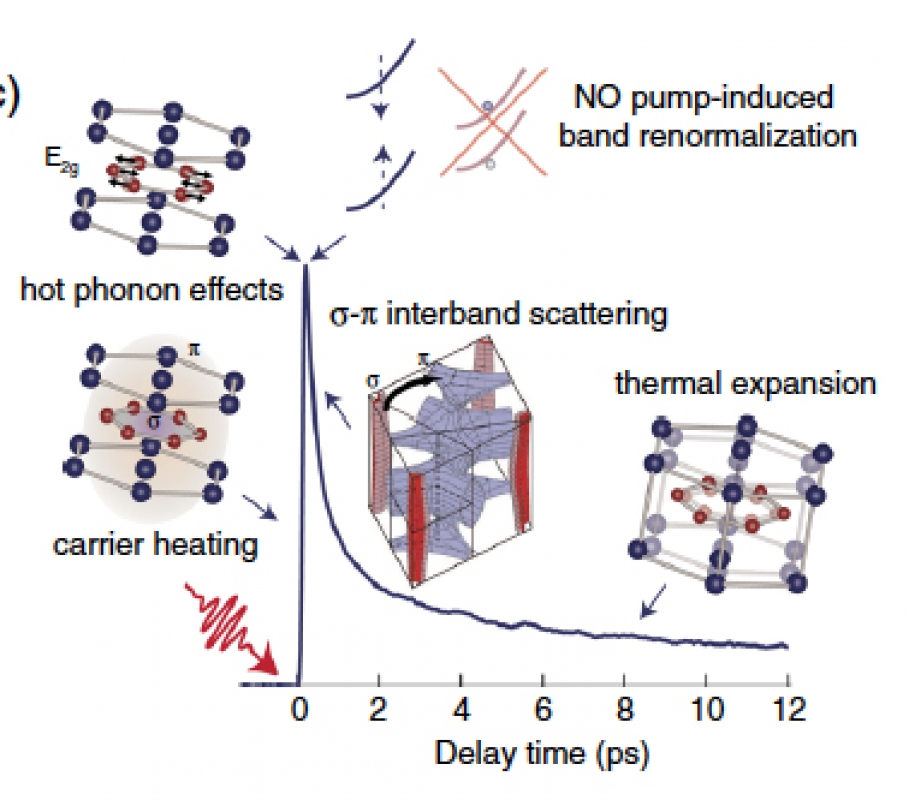Real-Time Observation of Phonon-Mediated σ−π Interband Scattering in MgB2
August 31, 2017Fabrizio Carbone and co-workers at EPFL open new perspectives for the selective carrier-density manipulation via near-infrared light.
Exotic phenomena and novel functionalities emerge in solids due to the coupling between the charge carriers and collective modes of structural, electronic, and magnetic origin. Key to exploiting this phenomenology is the ability to tune the density of carriers and the strength of their coupling to such modes. To gain control over the electronic density of states, advanced materials have been designed. Alternatively, photodoping or phonon pumping has been attempted to control the electronic density of states or the coupling between carriers and collective modes. The advantage of such an approach is that light does not induce structural disorder and can access new states of matter that only exist out of equilibrium.
Ultrafast techniques using visible light pulses have unveiled some of these phenomena by delivering excess energy to the electrons via an intense pump pulse and subsequently monitoring the transfer of such energy to the different underlying bosons via a delayed optical probe. Whenever a preferential electron-boson interaction channel exists, it dominates the carrier thermalization via simultaneous heating of the bosonic mode. Here, the authors used an ultrashort near-infrared laser pulse to set the σ-and π-electronic subsystems of MgB2 out of equilibrium and follow the change of the sample reflectivity ( ΔR/R) with a broadband probe covering the in-plane ( a axis) and out-of-plane ( c axis) plasma edges. The work shows that the photoinduced creation of a hot phonon bath in a multiband system can be used to selectively trigger a transient increase of the number of carriers in a given band, opening new perspectives for the selective carrier-density manipulation via near-infrared light. More generally, by setting a multiband system out of equilibrium, the microscopic details of the scattering mechanism between distinct electronic subsets can be unraveled via selective observables in the time domain.

Figure: Illustration of the ultrafast dynamics of MgB2. After the interaction with the solid, the ultrashort laser pulse leads to the excitation of both σ and π carriers. The nonthermal σ carriers are strongly coupled to the branch of the E2g phonon mode and efficiently generate hot phonons during the first 170 fs. Subsequently, the energy stored in the hot phonon subsystem is released to the π carriers via interband scattering and to low-energy phonons via anharmonic decay. The microscopic details of the interplay between the two subsystems in multi band superconductors were lacking to date and represent an important information for the manipulation of superconductivity in these type of materials.
Reference: Baldini, E., A. Mann, L. Benfatto, E. Cappelluti, A. Acocella, V. M. Silkin, S. V. Eremeev, A. B. Kuzmenko, S. Borroni, T. Tan, X. X. Xi, F. Zerbetto, R. Merlin and F. Carbone (2017). Real-Time Observation of Phonon-Mediated σ−π Interband Scattering in MgB2. Phys. Rev. Lett. 119: 097002 (10.1103/PhysRevLett.119.097002)
 Baldini-2017 (484 KB)
Baldini-2017 (484 KB)<<

 Ursula Keller wins “Swiss Nobel” Marcel Benoist Prize
Ursula Keller wins “Swiss Nobel” Marcel Benoist Prize Farewell: the NCCR MUST ended
Farewell: the NCCR MUST ended  MUST2022 Conference
MUST2022 Conference New scientific highlights
New scientific highlights FELs of Europe prize for Jeremy Rouxel
FELs of Europe prize for Jeremy Rouxel Ruth Signorell wins Doron prize
Ruth Signorell wins Doron prize New FAST-Fellow Uwe Thumm at ETH
New FAST-Fellow Uwe Thumm at ETH International Day of Women and Girls in Science
International Day of Women and Girls in Science New scientific highlight
New scientific highlight EU XFEL Young Scientist Award for Camila Bacellar,
EU XFEL Young Scientist Award for Camila Bacellar, Prizes for Giulia Mancini and Rebeca Gomez Castillo
Prizes for Giulia Mancini and Rebeca Gomez Castillo Nobel Prize in Chemistry awarded to RESOLV Member Benjamin List
Nobel Prize in Chemistry awarded to RESOLV Member Benjamin List Hans Jakob Wörner invited to give the „New Horizons Solvay Lectures”
Hans Jakob Wörner invited to give the „New Horizons Solvay Lectures”  Unusual keynote talk at an international scientific conference
Unusual keynote talk at an international scientific conference NCCR MUST at Scientifica 2021
NCCR MUST at Scientifica 2021